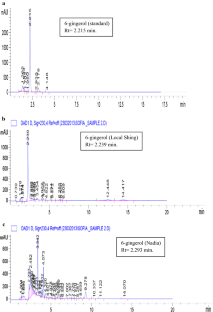Antioxidant activity of two commercial cultivars of ginger (Zingiber officinale Roscoe): Local Shing and Nadia found in Manipur
Research Articles | Published: 16 December, 2019
First Page: 100
Last Page: 105
Views: 4099
Keywords: Proximate analysis, Antioxidant, Gingerol, Shing and Nadia ginger (Zingiber officinale Roscoe)
Abstract
In the north-eastern part of India, ginger (Zingiber officinale Roscoe) is one of the prominent and widely cultivated cash crops. In Manipur, apart from standard cultivar like Nadia, local cultivars, Shing is a part of everyday local cuisine. A proximate analysis and antioxidant property of the two cultivars of ginger (Nadia as standard cultivar and Shing as local cultivar) were studied. It was observed that the Local Shing (ginger) has more fibre content than the Nadia ginger. The pungency in ginger is related to the content of gingerol. Gingerol and its related compound are well known for imparting pungency and have several pharmacological properties. The local cultivar is found to have high content of 6-gingerol which results in having high pungency quality making it a popular aromatic crop. Nadia ginger has less fibrous rhizome with lemony flavour and has more concentration of phenol, flavonoids, tannins content and high antioxidant activity.

References
- Ali BH, Blunden G, Tanira MO, Nemmar A (2008) Some phytochemical, pharmacological and toxicological properties of ginger (Zingiber officinal Roscoe): a review of recent research. Food Chem Toxicol 46(2):409–420. https://doi.org/10.1016/j.fct.2007.09.085
- Allen SE, Grimshaw HM, Rowland AP (1986) Chemical analysed. Moore PD and Chapman SB methods in plant ecology. Blackwell Scientific Publ, Oxford, pp 285–344
- Altman CD, Marcussen KC (2001) Effect of a ginger extract on knee pain in patient with osteoarthritis. Arthritis Rheum 44(11):2531–2538. https://doi.org/10.1002/1529-0131(200111)44:11%3c2531:aid-art433%3e3.0.co;2-j
- Amarowicz R (2007) Tannins: the new antioxidants? Editorial. Eur J Lipid Sci Technol 109:549–551. https://doi.org/10.1002/ejlt.200700145
- Astley S (2003) Dietary antioxidants-Past, present and future? Trends Food Sci Technol 14(3):93–98. https://doi.org/10.1016/s0924-2244(02)00281-9
- Chang CC, Yang MH, Wen HM, Chern JC (2002) Estimations of total flavonoid content in Propolis by two complementary colorimetric methods. J Food Drug Anal 10(3):178–182
- Fogliano V, Verde V, Randazoo F, Retieni X (1999) A method for measuring antioxidant activity and its application to monitoring the antioxidant capacity of wines. J Agric Food Chem 47:1635–1640. https://doi.org/10.1021/jf980496s
- ISTA (1996) International rules for seed testing association. ISTA 31:1–152
- Lee SK, Mbwambo ZH, Chung H, Luyengi L, Gamez EJ, Mehta RG, Kinghorn AD, Pezzuto JM (1998) Evaluation of the antioxidant potential of natural products. Comb Chem High Throughout Screen 1(1):35–46
- Lowry OH, Rosebrough NJ, Farr AL, Randl RJ (1951) Protein measurement with the folin phenol reagent. J Biol Chem 193:265–350
- Maynard AJ (1970) Methods in food analysis. Academic, New York, p 176
- MCS Donald, Prenzler PD, Autolich M, Robards K (2001) Phenolic content and antioxidant activity of olive extracts. Food Chem 73(1):73–84. https://doi.org/10.1016/s0308-8146(00)00288-0
- Pegg RB, Amarowicz R (2004) Meat protein-tannin interactions: observed antioxidant activity and potential health benefits. In: 50th International Congress of Meat Science and Technology, Helsinki, Finland
- Percival M (1998) Antioxidants. Clinical nutrition insights NUT031 1/96 Rev. 10/98
- Pereira DM, Valentao P, Pereira JA, Andrade PB (2009) Phenolics: from chemistry to biology. Molecules 14:2202–2211. https://doi.org/10.3390/molecules14062202
- Prakash V, Mehrotra BN (1996) Zingiberaceae of N.E. India: diversity and taxonomic status. In: Proceedings of the second symposium on family Zingiberaceae, South China Institute of Botany
- Rahman H, Karuppaiyan R, Kishore K, Denzongpa R (2009) Traditional practices of ginger cultivation in Northeast India. Ind J of Trad knowledge 8(1):23–28
- Schanderia SH (1970) Methods in food analysis. Academic press, New York, p 56
- Sharma GJ, Chirangini P, Kishor R (2011) Gingers of Manipur: Diversity and potential as bioresources. Genet Resour Crop Evol 58(5):753–767. https://doi.org/10.1007/s10722-011-9678-5
- Wood AB (1987) Determination of the pungent principles of chillies ad ginger by reversed—phase high-performance liquid chromatography with use of a single standard substance. Flavour Fragr J 2(1):1–12. https://doi.org/10.1002/ffj.2730020102
- Yadav RK, Yadav DS, Rai N, Sanwal SK, Sarma P (2004) Commercial prospects of Ginger cultivation in north eastern region. ENVIS Bull Him Ecol 12(2):1–5
- Zhang YX, Li JS, Chen LH, Peng WW, Cai BC (2012) Simultaneous determination of five gingerols in raw and processed ginger by HPLC. Chin Pharm J 47(6):471–474
- Zima T, Fialova L, Mestek O, Janebova M, Crkovska J, Malbohan I, Stipek S, Mikulikova L, Popov P (2001) Oxidative stress, metabolism of ethanol and alcohol-related diseases. J Biomed Sci 8(1):59–70. https://doi.org/10.1007/bf02255972
Author Information
Department of Life Sciences, Plant Physiology Section, Manipur University, Imphal, India